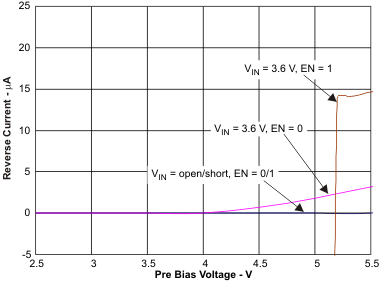SLVSA02B September 2009 – January 2019 TPS60151
PRODUCTION DATA.
- 1 Features
- 2 Applications
- 3 Description
- 4 Revision History
- 5 Device Comparison Table
- 6 Pin Configuration and Functions
- 7 Specifications
- 8 Detailed Description
- 9 Application and Implementation
- 10Power Supply Recommendations
- 11Layout
- 12Device and Documentation Support
- 13Mechanical, Packaging, and Orderable Information
Package Options
Mechanical Data (Package|Pins)
- DRV|6
Thermal pad, mechanical data (Package|Pins)
- DRV|6
Orderable Information
8.3.2 Output Reverse Current Protection
Applications like HDMI or USB OTG generally do not tolerate output reverse current that can drain power from connected devices. Special considerations were put in place to prevent that from happening. Figure 5 is a testing circuit; and, Figure 6 shows reverse current protection test results under various conditions.
 Figure 5. Output Reverse Current Test Setup
Figure 5. Output Reverse Current Test Setup  Figure 6. Reverse Current Test Results (Typical)
Figure 6. Reverse Current Test Results (Typical)